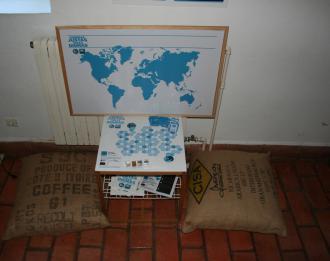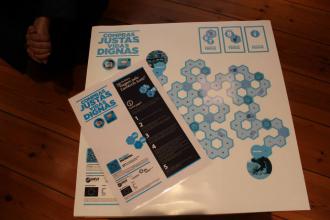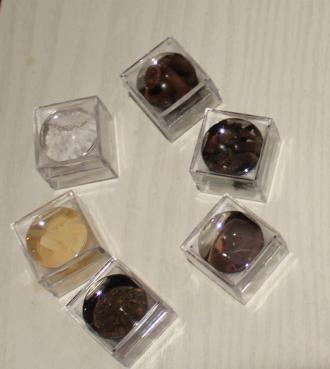How to do it step by step
1st Step:
What do we want to focus on and why?
Every day, from waking to bedtime, at home or in our working environment, we have access to a wide range of products: food, electronics, clothing, cosmetics, cultural products, and so on. But do we know where they come from? Or anything about their origin, life cycle, and the impact that their production, distribution and consumption has on different target groups? It was after considering these questions and reflecting on the coherence between promoting global values and consumer behaviour, that the project team decided to create an installation on fair trade.
2nd Step:
The location
It is important to ensure that our subject, as well as the approach that we want to take, complements the chosen area inside the Museum (consistent with the artefacts). This can be achieved by the relevance of the object, the room name or a whole set of factors that must first be identified.
3rd Step:
Get to work
Ideas are like gold dust, but unless they are made reality they turn into plain old dust. Indeed, after identifying the approach, the idea and the location to place the installation, we need to focus our attention on implementing our idea. As such, it is necessary to find suppliers capable of rising to the challenge, which in this case entailed producing an innovative installation at a low cost. As part of this process, we should always ask the Museum to pass on the details of companies with whom they usually work, to facilitate the call for bids process. In discussions with the project team, always consider the types of materials to be used in the installation, remembering to favour materials that are recycled, reused or environmentally and socially certified. During this process, there should be open dialogue and a willingness to adapt to new ideas..
4th Step:
Materials
You may or may not choose to have a set of support materials to raise further awareness on your topic. What kind of materials can we develop to support the creative, educational and informative aspects of the installation? How can we call on visitors to take action and to adopt sustainable consumer behaviour?
5th Step:
The message
When we talk about fair trade, we focus on a set of ethical, social, environmental and commercial dimensions that make reflecting on this issue a priority in terms of Education for Global Citizenship. However, when faced with space constraints, we should be able to select the most fundamental aspects and arouse the reader's curiosity to find out more.
Research: Collect data and facts, ensuring they are current, accurate, and from reliable and credible sources. If the data is complex, confusing or contradictory, the messages will be questioned by the reader.
Writing: The language should be accessible to all types of public, paying attention to typography (font, size and colour) to facilitate reading. The message cannot be biased and should present arguments based on facts that can be substantiated by the visitor.
Final text: We should present facts that can be substantiated and suggest ways to act. The text should be positive and optimistic.
6th Step:
Approval of the support materials
Leaflet: Visitors are invited to promote fair trade and the economic development of all continents, as well as to help reduce poverty. The brochure asks the visitor about his/her knowledge of what he/she consumes and of the working conditions involved in the production, processing and marketing of products. It also stresses the need for an overall change in the rules and practices of conventional trade and shows how a successful business can put people first. The wake-up call is delivered through a slogan: "Fair Shopping, Worthy Lives". It contains a clear and effective message that fair trade is a prerequisite for a dignified life.
Signpost: it attracts attention to the installation and the theme. Opt for a picture with a brief caption.
7th Step:
Setting up the installation in the museum
We sought to integrate the installation into a section of the museum that displays progress between the 1920s and the 1950s. We decided to address the issue of increased consumerism over that period to promote the idea of fair trade.
In order to vary the type of installation within the overall project, we chose to set up a board game. This would create a “stopping point” for visitors to reflect on this theme through interacting with the game. This game is a hybrid of two game genres: the “Jogo da Glória” (a variant on Snakes and Ladders using dice and a progression path) and “Trivial Pursuit” (the use of cards with questions and answers).
Game elements: two dice and six playing pieces made from glass cases filled with fair trade products (such as coffee, rice, textiles, chocolate, sugar, tea and spices).
The board game has two levels of difficulty suitable for the skills and motivations of two age groups:
- Level 1. Children aged between five and seven
- Level 2. Older than 8 years of age
The game
The game is based on the logic of the “Jogo da Glória”, where children travel along the game path symbolizing the topic of fair trade. In each position along the path there are different colours and icons. Each colour code corresponds to certain cards that must be read. The cards are divided into two categories, according to the children's level. There are 20 cards with questions (10 cards in each category).
The installation is accompanied by two beanbags made from old coffee sacks.
The installation was placed next to objects illustrating the domestic environment of families living between the 19th century and the mid-20th century. This domestic environment is based around textiles and costumes. Through furniture, photographs and newspapers, we may learn about how the household developed during this era. On display are several products that can be acquired ethically and fairly (like tea and textiles).
8th Step:
Communication plan
The installation was inaugurated on World Tea Day (December 15). As Christmas falls within this month, it is also a season characterized by consumerism. The installation was thus associated with the need to ensure fair and equitable trade. Over the following days, we continued to post computer graphics, reports, videos and images to raise awareness on the need to adopt fair and ethical consumer behaviour.
9th Step:
Inauguration of the installation
If appropriate and if the museum is big enough, you may wish to hold an official inauguration of the installation, which could follow various formats including debates, movie previews, or family activities. One example would be for museum staff to host and promote a “fair tea” session.






















